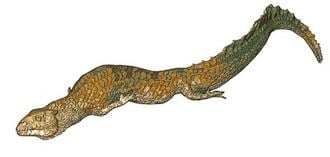Kingdom Animalia Clade Archosauriformes Rank Genus | Class Reptilia Phylum Chordata | |
 | ||
Similar Doswellia, Archosauriformes, Tropidosuchus, Chanaresuchus, Erythrosuchus | ||
Vancleavea is a genus of extinct, armoured, non-archosaurian archosauriform with relatively small limbs from the Late Triassic of western North America. The type and only species is V. campi, named by Robert Long & Phillip A Murry, 1995. A nearly complete and articulated skeleton was discovered at the Coelophysis Quarry in north-central New Mexico (Ghost Ranch), USA, and was prepared at the Ruth Hall Museum of Paleontology in Abiquiú, New Mexico before being formally described in the Zoological Journal of the Linnean Society in 2009. Vancleavea was first discovered in 1962 from the Petrified Forest Member of the Petrified Forest National Park and initially described by Long and Murry in 1995. The genus is named after Phillip Van Cleave, who discovered the first known remains of the genus. Vancleavea is a fairly common occurrence in most levels of the Chinle Formation, however, due to the poorly preserved remains, it is difficult to compare specimens across stratigraphic levels.
Contents

Description

Vancleavea was around 1.2 m (3.9 ft) in length. Imbricating osteoderms cover the entire body, the limbs are relatively short, and the skull is highly ossified. The supratemporal fenestra is absent, which may represent a secondary closure rather than a plesiomorphic trait. The nares open dorsally (i.e. nostrils face upward) and the jaw contains enlarged caniniform fangs. Each osteoderm possesses a pronounced central keel and an anterior projection. The illium of Vancleavea resembles those of unrelated drepanosaurs. The unique morphology of Vancleavea differs greatly from any other known basal archosauriform.
Phylogenetics

Before the genus was described 1995, an additional specimen consisting of fragmentary skull material found by Charles Camp in 1923 was suggested to belong to a proterochampsid. However, this material was later referred to a new taxon, Acallosuchus rectori, after having been shown to be distinct from the postcranial material found in 1962. In the initial description of Vancleavea, the genus was referred to Neodiapsida incertae sedis along with A. rectori.

A 2008 phylogenetic study tentatively suggested that Vancleavea was a basal archosauriform more derived than Erythrosuchus, Proterosuchus, and possibly even Euparkeria. In a new 2009 study, Vancleavea was found to be more closely related to Archosauria than both Erythrosuchus and Proterosuchus, and was also found to be outside of the crown group, with Euparkeria remaining the closest sister taxon of Archosauria.

Controversy still remains as to whether or not the specimens referred to this genus are representative of a "single species-level taxon or a clade of closely related taxa that lived through much of the Late Triassic of North America, given the poor fossil record of the taxon." Differences in the osteoderms as well as the shape of the internal tuberosity of the humerus in different specimens may suggest that they belong to different taxa, but because of the fragmentary preservation of these fossils, unambiguous autapomorphies cannot be distinguished that would indicate that there are different taxa.
Paleobiology

Vancleavea has features that suggest a semi-aquatic lifestyle. These include the long body, short limbs, and deep tail. Vancleavea is unique among archosauriforms and tetrapods in general in that the fin-like tail is deepened by elongated osteoderms rather than tall neural spines.
